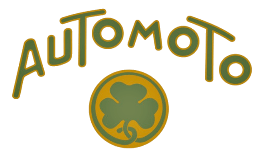


Established in Saint Etienne in 1899, the firm built tricycles closely based on those of De Dion. These used higher quality materials and for the most part were superior to the original. Baron De Dion was not impressed, and sued Automoto. He lost.
By 1914 the company was flourishing. Their motorcycles were powered by the most advanced and powerful engines of the day - they were more expensive than most of the competition, but achieved an outstannding reptutation and as a result sales were excellent.
After the 1914-1918 war the company was in poor condition and had a considerable difficulty restarting motorcycle production. However, by 1923 Automoto had achieved a reasonably good market position through quality bicycles. In 1923 they introduced to a 100cc two-stroke velomoteur and 175cc models with 2 and 3-speed gearboxes.
Later, the range of models was expanded to include 250 and 350cc models (1927) and a 500cc model followed.
Automoto motorcycles were aimed at customers willing to pay a bit more for a high quality machine. However, pricing became problematical with the onset of the economic crisis towards the end of the 1920s. In 1930, the Automoto company was bought by Peugeot, which kept the factory in Saint Etienne primarily for the manufacture of components. After World War II the company produced mainly Peugeot motorcycles.
They began fitting engines from AMC and Villiers to their motorcycles, and expanded into the velomoteur sector with 50-125cc machines. Relatively few larger machines were built.
In 1959 the company merged with Indénor, a Peugeot subsidiary and owner of Terrot, and subsequently Terrot and Automoto models were very similar.
By 1962 Automoto was one of the few surviving French motorcycle brands. In July of that year production of bicycles and motorcycles ceased.
Automoto Company Information